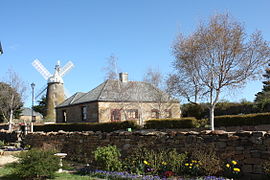Oatlands, Tasmania
|
Oatlands Tasmania |
|||||||
|---|---|---|---|---|---|---|---|

View of Callington mill.
|
|||||||

Oatlands Coach House, typical sandstone building
|
|||||||
| Coordinates | 42°18′00″S 147°22′14″E / 42.30000°S 147.37056°ECoordinates: 42°18′00″S 147°22′14″E / 42.30000°S 147.37056°E | ||||||
| Population | 540 (2006 census) | ||||||
| Postcode(s) | 7120 | ||||||
| Elevation | 406 m (1,332 ft) | ||||||
| Location |
|
||||||
| LGA(s) | Southern Midlands Council | ||||||
| State electorate(s) | Lyons | ||||||
| Federal Division(s) | Lyons | ||||||
|
|||||||
Oatlands is an important historical village on the shores of Lake Dulverton in the centre of Tasmania, Australia. Oatlands is located 84 km north of Hobart and 115 km south of Launceston on the Midland Highway. At the 2006 census, Oatlands had a population of 540.
Oatlands is considered to have the largest number of colonial sandstone buildings in any town in Australia, and many of them were built by convict labour. It is the largest town in the Southern Midlands Council area and is surrounded by rich agricultural land.
Oatlands is served by 97.1 MID FM "The Voice of the Midlands"
Oatlands is one of Tasmania's oldest settlements and was named by Governor Macquarie after an English town in the county of Surrey in 1821. It was developed as a military base for the control and management of convicts because of its central location between Hobart and Launceston. Convicts were assigned to nearby farms and properties, and also worked on public buildings, roads and bridges.
Oatlands Post Office opened on 1 June 1832.
Much of the Black War (early settlers against local aborigines) took place in the surrounding districts, and Oatlands was also the home of the ex-convict Solomon Blay, Tasmania's most feared hangman. There are a number of unique landmarks in Oatlands, including the Callington Mill and St Pauls' Church. The mill was built in 1837 and was restored to working order during June/July 2010, and the Catholic Church was designed by Augustus Welby Pugin, the father of Gothic Revival architecture.
For some years after 1848, Oatlands was the place of exile of the Irish nationalist leader Kevin Izod O'Doherty, where his stone cottage still stands. A railway connected Oatlands with Parattah Junction, on the main Hobart to Launceston line. The railway opened on 13 May 1885 and it closed on 10 June 1949.
...
Wikipedia

